The AMD Radeon R9 295X2 Review
by Ryan Smith on April 8, 2014 8:00 AM EST- Posted in
- GPUs
- AMD
- Radeon
- Radeon 200
Thief
Our newest addition to our benchmark suite is Eidos Monreal’s stealth action game, Thief. Set amidst a Victorian-era fantasy environment, Thief is an Unreal Engine 3 based title which makes use of a number of supplementary Direct3D 11 effects, including tessellation and advanced lighting. Adding further quality to the game on its highest settings is support for SSAA, which can eliminate most forms of aliasing while bringing even the most powerful video cards to their knees.

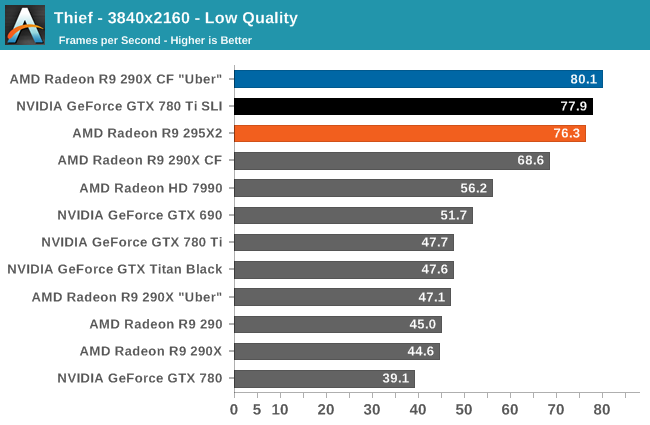
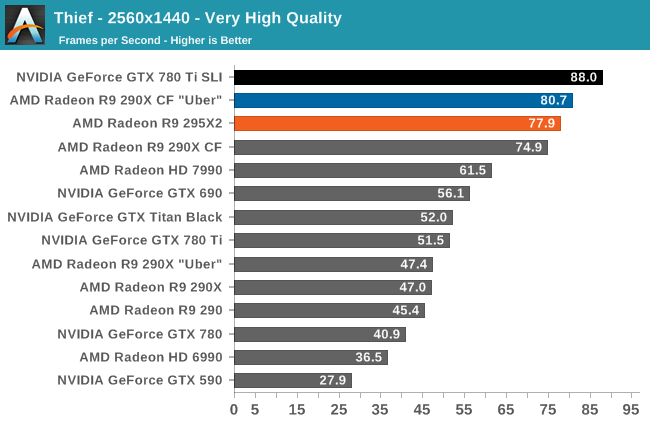
Our first major review with Thief finds AMD taking a small lead at 2160p, with NVIDIA returning the favor at 1440p. In the case of 1440p both the AMD and NVIDIA setups are able to deliver well over 60fps (despite the heavy use of SSAA at this setting), while at 2160p even the 295X2 falls just a hair short of cracking 60fps even with the slightly lower quality settings.
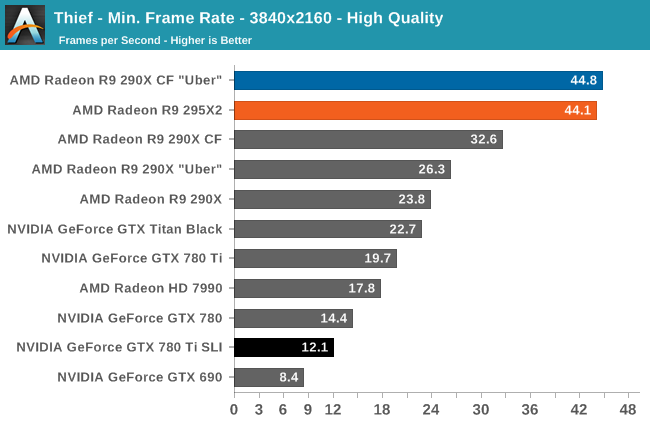
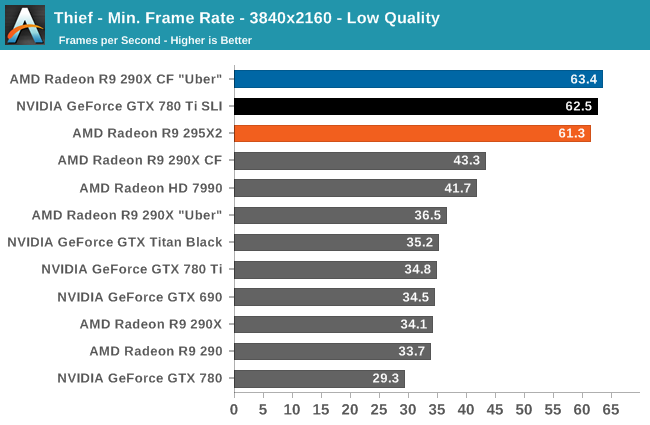

Meanwhile when it comes to minimum framerates, while AMD and NVIDIA are close together at 1440p and 2160p with Low quality settings, moving to 2160p with High quality settings pretty much busts the NVIDIA SLI setup. It’s difficult to say for sure on the basis of a single SLI setup, but it looks like the memory requirements at these settings may be overwhelming the 3GB NVIDIA cards, especially in light of the GTX Titan Black’s unusual performance lead over the GTX 780 Ti. The additional buffer handling for SLI further eats into the pool of memory available for these cards, which in turn further hamstrings performance.

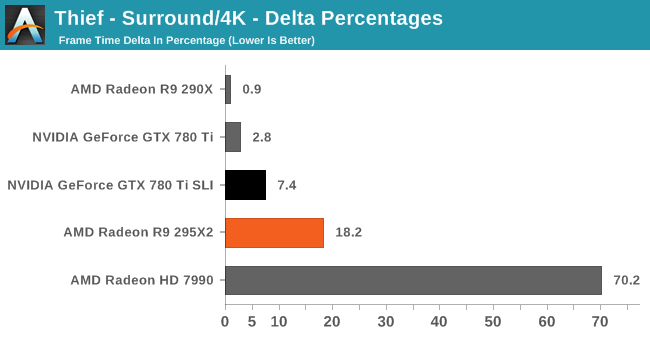
On the other hand, other than the GTX 780 SLI’s initial bottoming out in this benchmark, NVIDIA does deliver stronger frame pacing performance. In both cases the 295X2 delivers acceptable consistency, staying under 20% variance, but it’s still a wider degree of variance than what we’re seeing with the GTX 780 Ti SLI setup.


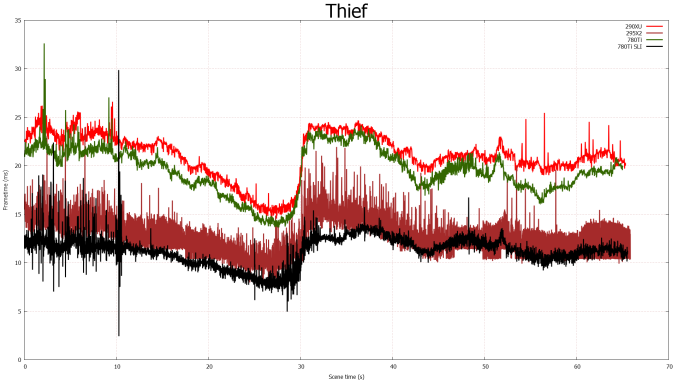
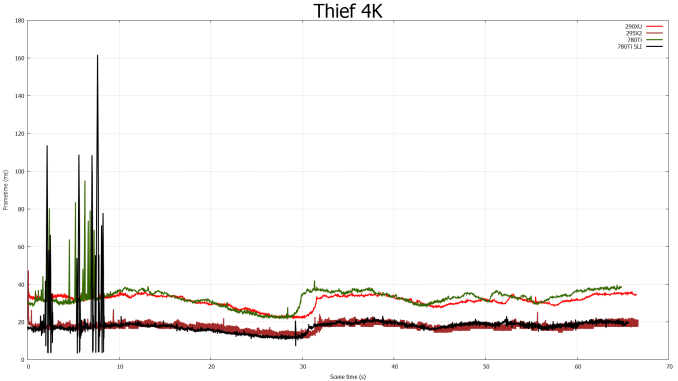








131 Comments
View All Comments
mpdugas - Wednesday, April 9, 2014 - link
Time for two power supplies in this kind of build...rikm - Wednesday, April 9, 2014 - link
huh?, no giveaway? why do I read this stuff?ok, seriously, love these reviews, but the thing I never understand is when they say Titan is better, but the charts seem to say the opposite, at least for compute.
lanskywalker - Wednesday, April 9, 2014 - link
That card is a sexy beast.jimjamjamie - Thursday, April 10, 2014 - link
Great effort from AMD, I wish they would focus on efficiency though - I feel with the changing computing climate and the shift to mobile that power-hungry components should be niche, not the norm.Basically, a dual-750ti card would be lovely :)
IUU - Saturday, April 12, 2014 - link
The sad thing about all this, is that the lowest resolution for these cards is considered to be the 2560x1440 one(for those who understand).Bigger disappointment yet, that after so many years of high expectations, the gpu still stands as a huge piece of silicon inside the pc that's firmly chained by the IT industry to serve gamers only.
Whatever the reason for no such consumer applications,thiis is a crime, mildly put.
RoboJ1M - Thursday, May 1, 2014 - link
The 4870 stories that were written here by Anand were my most memorable and favourite.That and the SSD saga.
Everybody loves a good Giant Killer story.
But the "Small Die Strategy" has long since ended?
When did that end?
Why did that end? I mean, it worked so well, didn't it?
patrickjp93 - Friday, May 2, 2014 - link
People should be warned: the performance of this card is nowhere close to what the benchmarks or limited tests suggest. Even on the newest Asrock Motherboard the PCI v3 lanes bottleneck this about 40%. If you're just going to sequentially transform the same data once it's on the card, yes, you have this performance, which is impressive for the base cost, though entirely lousy for the Flop/Watt. But, if you're going to attempt to be moving 8GB of data to and from the CPU and GPU continuously, this card performs marginally better than the 290. The busses are bridge chips are going to need to get much faster for these cards to be really useful for anything outside purely graphical applications in the future. It's pretty much a waste for GPGPU computing.patrickjp93 - Friday, May 2, 2014 - link
*The busses AND bridge chips...* Seriously what chat forum doesn't let you edit your comments?Gizmosis350k - Sunday, May 4, 2014 - link
I wonder if Quad CF works with theseBlitzninjasensei - Saturday, July 12, 2014 - link
I'm trying to imagine what kind of person would have 4 of these and why, maybe EyeFinity with 4k? Even then your CPU would bottleneck way before that, you would need some kind of motherboard with dual CPU slots and a game that can take advantage of it.